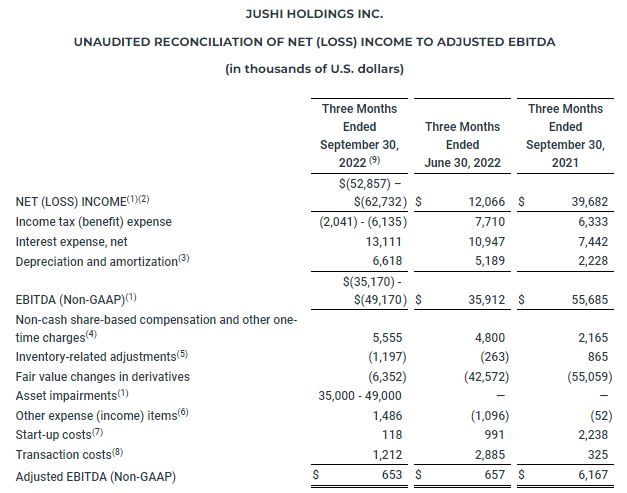
Jushi Holdings Inc. Reports Preliminary Third Quarter 2022 Financial Results
- Year-over-Year Revenue Growth of 34.9% to $72.8 million
- Strong Retail Performance and Patient Expansion in Virginia with 48.4% Sequential Increase in Retail Sales in the Commonwealth
BOCA RATON, Fla., Nov. 14, 2022 (GLOBE NEWSWIRE) — Jushi Holdings Inc. (“Jushi” or the “Company”) (CSE: JUSH) (OTCQX: JUSHF), a vertically integrated, multi-state cannabis operator, announced certain preliminary financial results for the quarter ended September 30, 2022 (“Q3 2022”). The Company also announced that it is in the process of completing its interim asset impairment assessment and expects to record a non-cash, indefinite-lived asset impairment charge in the range of $35.0 to $49.0 million (after-tax of $24.8 to $34.7 million). All financial information is provided in U.S. dollars unless otherwise indicated and is prepared under U.S. Generally Accepted Accounting Principles (“GAAP”).
Third Quarter 2022 Financial Highlights1
- Total revenue of $72.8 million, an increase of 34.9% year-over-year, and flat as compared to the quarter ended June 30, 2022 (“Q2 2022”)
- Gross profit of $27.7 million, an increase of 18.9% year-over-year and 4.0% as compared to Q2 2022
- Net loss in the range of $52.9 to $62.8 million
- Adjusted net loss2, excluding the after-tax indefinite-lived asset impairment charge, of $28.1 million
- Adjusted EBITDA2 of $0.7 million
- Cash and cash equivalents were $31.1 million as of the quarter end
1 See “Financial Disclosure Advisory” below.
2 See “Use of Non-GAAP Financial Information” and “Reconciliation of Non-GAAP Financial Measures” below
Third Quarter 2022 Operational Highlights
- Opened the 34th and 35th retail locations nationwide and third and fourth Beyond Hello™ dispensary locations in Virginia
- Expanded overall canopy by 11,000 sq. ft. to a total of 80,000 sq. ft. and increased annual biomass capacity by 7,300 lbs. to a total of 45,500 lbs.
- Added nearly 8,000 new patients in Virginia in Q3 2022, compared to approximately 1,950 patients in Q2 2022. In October, the Company added 2,425 new patients
Recent Developments
- Relocated the Beyond Hello™ Westside dispensary in Pennsylvania to Dickson City in the Greater Scranton Area
- Debuted newly formulated cannabis infused fruit chews by Tasteology in Massachusetts, available in three new vegan, gluten-free varieties with upgraded sustainable packaging
- Announced partnership with Drop4Drop, a non-profit organization dedicated to helping alleviate the world water crisis, to fund clean water projects across six countries
- Strengthened Board of Directors and senior leadership with the appointment of Bill Wafford as an Independent Director and Chair of the Audit Committee, and Tobi Lebowitz to Chief Legal Officer and Corporate Secretary
Management Commentary
“We remain focused on executing our strategic initiatives to strengthen and expand our operating platform,” said Jim Cacioppo, Chief Executive Officer, Chairman and Founder of Jushi. “During the third quarter, we bolstered our retail portfolio with the addition of two new stores in Virginia, moved closer to full-scale production at our grower-processor facilities in Pennsylvania and Virginia, and expanded our Jushi branded product portfolio across our operational vertically integrated markets. As we approach the end of the year, we expect to begin realizing the benefits of our efforts as we transform the business from substantially retail only and selling mostly third party product, to a company that is vertically integrated.”
As we look out to 2023 and beyond, we anticipate that our sales growth and improved profitability will be driven by the growth of the Virginia market, increased production and sell-through of high quality products produced at our grower-processor facilities, and our portfolio of assets focused in markets that are well positioned to take advantage of future state-level regulatory developments.
 Jim Cacioppo, Chief Executive Officer, Chairman and Founder of Jushi
Jim Cacioppo, Chief Executive Officer, Chairman and Founder of Jushi
I am incredibly pleased with the significant progress we have made year-to-date and remain highly confident in our market position as we close out the year.
Financial Results for the Third Quarter 20221
The following is a tabular summary and commentary of revenue, gross profit, net income (loss), and net income (loss) per share for the three-month periods ended September 30, 2022, June 30, 2022, and September 30, 2021.
Revenue in Q3 2022 increased 34.9% to $72.8 million as compared to $54.0 million in the third quarter of 2021 (“Q3 2021”). The net increase was primarily driven by the Company’s acquisitions in Nevada and Massachusetts, new Beyond Hello™ store openings in Virginia, along with increased sales at existing stores in Virginia. On a sequential basis, revenue was essentially flat, driven by strong contributions from retail sales in Virginia and Massachusetts and increased wholesale sales in Nevada, offset by a decrease in retail sales in Pennsylvania and Nevada.
Gross profit in Q3 2022 was $27.7 million, or 38.1% of revenue, compared to $26.7 million, or 36.7% of revenue in Q2 2022. The increase in gross margin was primarily driven by an increase in the sell-through rate of Jushi’s private branded products, partially offset by increased promotional activity of Jushi branded products in Pennsylvania.
Q3 2022 net loss, including an indefinite-lived asset impairment charge in the range of $35.0 to $49.0 million, was $52.9 to $62.8 million, compared to net income of $12.1 million in Q2 2022. Adjusted net loss2, excluding the after-tax impairment charge, was $28.1 million.
Adjusted EBITDA2 in Q3 2022 was $0.7 million, which was flat as compared to $0.7 million in Q2 2022, and a decrease of $5.5 million compared to $6.2 million in Q3 2021. Adjusted EBITDA benefited from increased sales of Jushi branded products, offset by infrastructure and headcount investments at the Company’s grower processors that continue to have a transitional impact as the business scales, and slower-than-expected growth of wholesale operations.
1 See “Financial Disclosure Advisory” below.
2 See “Use of Non-GAAP Financial Information” and “Reconciliation of Non-GAAP Financial Measures” below.
Balance Sheet and Liquidity
As of September 30, 2022, the Company had approximately $31.1 million of cash and cash equivalents. The Company paid approximately $8 million in capital expenditures during Q3 2022. We expect capital expenditures in the fourth quarter to be in the range of $5 to $15 million, prior to any potential tenant improvement reimbursements or financings, for a total of approximately $55 to $65 million for the full year 2022, subject to market conditions and regulatory changes. As of September 30, 2022, the Company had approximately $209 million in principal amount of total debt, excluding leases and property, plant, and equipment financing obligations. As of November 11, 2022, the Company’s issued and outstanding shares were 195,776,372 and its fully diluted shares outstanding were 290,606,855.
Financial Disclosure Advisory
The Company has not yet completed its reporting process for Q3 2022. The preliminary results presented herein are based on the Company’s reasonable estimates and the information available to the Company at this time and, because of their preliminary nature, in certain cases, the Company has provided ranges, rather than specific amounts. As such, the Company’s actual results may materially vary from the preliminary results presented herein and will not be finalized until the Company reports its final results for Q3 2022 after the completion of its normal quarter end accounting and review procedures, including its interim asset impairment assessment. In addition, any statements regarding the Company’s estimated financial performance for the Q3 2022 does not present all information necessary for an understanding of the Company’s financial condition and results of operations as of and for Q3 2022. The preliminary financial results presented herein was not reviewed by our independent registered public accounting firm.
Use of Non-GAAP Financial Information
We believe that the presentation of non-GAAP financial information provides important supplemental information to management and investors regarding financial and business trends relating to our financial condition and results of operations. For further information regarding these non-GAAP measures, including the reconciliation of these non-GAAP financial measures to their most directly comparable GAAP financial measures, please refer to the financial table below, as well as the “Reconciliation of Non-GAAP Financial Measures” section of this press release.
Conference Call and Webcast Information
The Company will host a conference call to discuss its financial results for the third quarter 2022 at 9:00 a.m. ET today, Monday, November 14, 2022.
Event: Third Quarter 2022 Financial Results Conference Call
Date: Monday, November 14, 2022
Time: 9:00 a.m. Eastern Time
Live Call: 1-866-374-5140 (U.S. Toll-Free) / 1-866-455-3403 (Canada Toll-Free)
Conference ID: 42084746#
Webcast: Register
For interested individuals unable to join the conference call, a webcast of the call will be available for one year following the conference call and can be accessed via webcast on Jushi’s Investor Relations website.
About Jushi Holdings Inc.
We are a vertically integrated cannabis company led by an industry-leading management team. In the United States, Jushi is focused on building a multi-state portfolio of branded cannabis assets through opportunistic acquisitions, distressed workouts, and competitive applications. Jushi strives to maximize shareholder value while delivering high-quality products across all levels of the cannabis ecosystem. For more information, visit jushico.com or our social media channels, Instagram, Facebook, Twitter and LinkedIn.
JUSHI HOLDINGS INC.
Reconciliation of Non-GAAP Financial Measures
Adjusted net loss, EBITDA and Adjusted EBITDA
In addition to providing financial measurements based on GAAP, the Company provides additional financial metrics that are not prepared in accordance with GAAP. Management uses non-GAAP financial measures, in addition to GAAP financial measures, to understand and compare operating results across accounting periods, for financial and operational decision making, for planning and forecasting purposes and to evaluate the Company’s financial performance. These non-GAAP financial measures are Adjusted net loss, EBITDA and Adjusted EBITDA (each as defined below). Management believes that these non-GAAP financial measures reflect the Company’s ongoing business by excluding the effects of expenses that are not reflective of our operating business performance and allows for meaningful comparisons and analysis of trends in the business. These non-GAAP financial measures also facilitate comparing financial results across accounting periods and to those of peer companies. As there are no standardized methods of calculating these non-GAAP measures, the Company’s methods may differ from those used by others, and accordingly, the use of these measures may not be directly comparable to similar measures used by others, thus limiting their usefulness. Accordingly, these non-GAAP measures are intended to provide additional information and should not be considered in isolation or as a substitute for measures of performance prepared in accordance with GAAP.
Adjusted net loss, EBITDA and Adjusted EBITDA are financial measures that are not defined under GAAP. Management defines Adjusted net loss as net loss excluding the after-tax indefinite-lived asset impairment charge. Management defines EBITDA as net income (loss), or “earnings,” before interest, income taxes, depreciation and amortization. Management defines Adjusted EBITDA as EBITDA before: (i) non-cash share-based compensation expense and other one-time charges; (ii) inventory-related adjustments; (iii) fair value changes in derivatives; (iv) asset impairments; (v) other (income)/expense items; (vi) transaction costs; and (vii) start-up costs. These financial measures are metrics that have been adjusted from the GAAP net income (loss) measure in an effort to provide readers with a normalized metric in making comparisons more meaningful across the cannabis industry, as well as to remove non-recurring, irregular and one-time items that may otherwise distort the GAAP net income measure. Other companies in the Corporation’s industry may calculate this measure differently, limiting their usefulness as comparative measures.
(1) Impacted by management’s estimate of impairment charge on indefinite-lived intangible assets; Some of the key assumptions impacting this estimate are discount rates and forecasted cash flows.
(2) Net income (loss) includes amounts attributable to non-controlling interests.
(3) Includes amounts that are included in cost of goods sold and in operating expenses; Q2 2022 has been revised to include estimated unabsorbed depreciation expense.
(4) Includes: (i) non-cash share-based compensation expense for the period; and (ii) severance costs.
(5) Includes: (i) inventory step-up on business combinations; (ii) inventory recall reserves; and (iii) reserves for discontinued products. The inventory step-up on business combinations relate to the fair value write-up on inventory acquired on the business acquisition date and then sold subsequent to the acquisition date. The inventory recall reserves relate to the estimated impact of the Pennsylvania Department of Health recall and ban of vape products containing certain cannabis concentrates. The ban was lifted in June 2022. Q2 2022 has been revised to include the impact of recall reserve reversals during the period.
(6) Includes: (i) remeasurement of contingent consideration related to acquisitions; (ii) losses (gains) on investments and financial assets; and (iii) losses (gains) on legal settlements.
(7) Expansion and start-up costs incurred in order to prepare a location for its intended use. Start-up costs are expensed as incurred and are not indicative of ongoing operations of each new location.
(8) Transaction costs include: (i) registration statement costs such as professional fees and other costs relating to our SEC registration; and (ii) acquisition and deal costs.
(9) See “Financial Disclosure Advisory” above.


